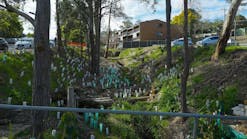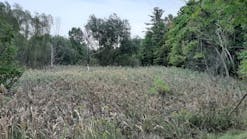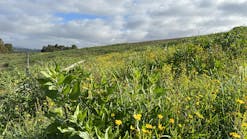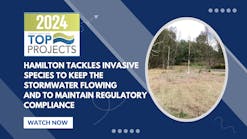Cost-Effective Erosion Control With Blankets and Mats
Today’s tough federal and state environmental laws force both public and private developers to be much more careful in developing a construction site than in the past. National Pollutant Discharge Elimination System (NPDES) Phase II permits are required for construction activities disturbing more than 1 ac. (down from 5 ac. under NPDES Phase I), and many states now require developers to produce a formal erosion and sedimentation control (ESC) plan if they intend to disturb as little as an acre of land. Some maintain that much of today’s erosion control industry has been legislated into existence over the past few decades through USEPA and state-level department of environmental protection guidelines and regulations.
The upshot: Developers have had to become far more diligent in preventing erosion on the construction site-not just after construction is completed, but also during the construction phase itself. Once an area has been graded, a developer must move quickly to seed and then protect it from the erosive effects of wind and rain. Numerous techniques and products for controlling erosion and sedimentation, from hydomulching to hay and straw mulching to temporary erosion control blankets, have been developed. Stricter regulation has also resulted in the construction of many more channels and ditches for gathering stormwater on construction sites-be it along a highway or on a commercial or residential development-before it can do erosive damage, then safely routing it to nearby sedimentation (temporary) or detention (permanent) basins. Developers also face the problem of how best to prevent those channels and ditches themselves from eroding every time they carry a surge of stormwater-and that’s where permanent turf reinforcement mats (TRMs) have been playing a rapidly expanding role.
Not surprisingly, state departments of transportation are among the most active organizations in erosion and sedimentation control. Yet there seems to be considerable variation in philosophy and approach from state to state. We have singled out three states with varying terrains and climates-Pennsylvania, Colorado, and Texas-to examine how practices vary.
Pennsylvania: Fertile and Cost-Conscious
As Jeff Smallman, project development engineer with the Pennsylvania Department of Transportation (PennDOT) District 5 (Allentown), explains, state environmental laws require a developer, private or public, to prepare an ESC plan anytime it intends to disturb an acre or more of soil. The plan must be approved by the local county soil conservation district, to which enforcement of the state’s erosion control laws in any given county has been delegated. If less than an acre is to be disturbed, the developer must still construct standard measures to control erosion and sedimentation, but no formal plan is needed. A plan can be quite elaborate: one ESC plan for a $90 million highway extension in Easton, PA, ran 300 pages.
PennDOT works closely with local county soil conservation districts in the state to come up with effective ways to minimize erosion. According to Smallman, PennDOT currently spends about 10% of construction costs on ESC measures-and is eager to hold the line there. Only a decade or so ago, prior to the tougher new laws, Pennsylvania and many other states spent very little on ESC. County soil conservation districts, he observes, are nowhere near as cost-conscious as private and public developers; they focus mainly on preventing erosion and sedimentation rather than holding down construction costs. PennDOT is likewise environmentally sensitive and does not want to contribute any sediment to commonwealth waters. Yet it also has a responsibility, Smallman emphasizes, to spend the public’s highway-construction dollars prudently. This acute cost-consciousness permeates PennDOT’s approach to erosion control.
Concerning the protection of newly graded and seeded slopes and embankments against erosion, PennDOT’s first defense, Smallman explains, is to avoid wherever possible designing slopes steeper than 2:1 (horizontal to vertical). Steeper slopes create both slope-stability and erosion problems. He estimates that in 95% of new highway projects in recent years, the embankments and cuts constructed have slopes of 2:1 or less. In Pennsylvania and several other states, temporary erosion control blankets are stapled down only on freshly graded slopes 2:1 or steeper (in other states the guideline is for slopes 3:1 or steeper); for less steep slopes, less costly options are usually used.
For shallower slopes, the first line of defense is to construct a channel or a ditch along the top of the slope or embankment to intercept runoff about to run down the slope. Collected stormwater is then conveyed to the base of the slope via a temporary corrugated slope pipe, and from there a channel conveys the water to a sedimentation or detention basin.
In protecting newly graded slopes that are 4:1 or flatter, Smallman says, PennDOT merely seeds the slope and mulches with loose straw or hay; no plastic netting is applied. For slopes of 4:1 up to 2:1, PennDOT first seeds, then applies hay or straw mulch, and finally lays down a plastic netting over the mulch to keep it from washing or blowing away. Smallman maintains that such a cost-effective solution has worked well. Slopes steeper than 2:1 are often reinforced with geogrid, and then a temporary blanket is stapled down to the freshly seeded surface.
Where temporary erosion control blankets and permanent TRMs find their greatest application in PennDOT, Smallman explains, is in the temporary or permanent lining of stormwater channels and ditches. In designing for a two-year storm, engineers calculate the expected water velocities. For relatively low-velocity channels, the solution can be as simple as seeding with grass seed, then placing a loose straw or hay mulch on top of it; or for higher anticipated stormwater velocities, it might involve placing a plastic net over the straw or using greater protection, such as a blanket of straw, jute, coconut fiber (coir), or excelsior. After several months, the new stand of grass that has sprouted up in the channel will provide permanent erosion protection. If anticipated channel velocities are higher than vegetation alone can withstand, PennDOT resorts to a more costly synthetic permanent TRM. Smallman is enthusiastic about the cost-saving potential of using permanent TRMs in channels compared to other alternatives. “A synthetic mat is much cheaper than using either riprap or concrete to line a channel. It is just a matter of rolling out the mat and pinning it down.” However, where anticipated velocities are too high even for reinforced turf-greater than 9-10 ft./sec.-the channel is lined with riprap, and where there is concern the runoff might gouge out a sinkhole, PennDOT uses concrete channel lining.
Highways Versus Commercial and Residential Development
According to Craig Momose, a civil engineer with the civil engineering consulting firm of Stackhouse, Seitz & Besinger in Reading, PA, erosion control blankets and TRMs find their greatest use in the temporary or permanent protection of newly constructed and seeded drainage channels, swales, or ditches along highways and in new commercial and residential developments. The Berks County Soil Conservation District and others in the state require that a temporary erosion control blanket be used on newly seeded slopes steeper than 3:1. But the majority of applications for erosion control blankets, Momose believes, are for temporarily lining channels and ditches until a dense stand of grass can be grown to provide natural protection.
Steeper slopes are more common in highway work than in private developments, Momose observes, because highway rights of way are often narrow, forcing the highway designer to construct a steep slope. Private developers, on the other hand, are grading wider expanses to avoid creating steep slopes on their sites, which inhibit the land’s usefulness. Most steep slopes requiring temporary blanket protection lie along new highways or reconstructed sections of existing highways-not on established highways, where long-established stands of grasses continue to protect slopes against erosion.
Landfills are another area, Momose points out, where steep slopes are to be found and where temporary erosion control blankets are often used to protect newly seeded slopes until a dense stand of grass can be grown. Typically a landfill will have a 20-ft.-long slope (walking transversely down the landfill), then a horizontal bench, then another 20-ft.-long slope, and so on. Stormwater flows down the 20-ft.-long slopes and is collected by channels running along the bench area. These channels then conduct collected stormwater to an onsite detention basin. Temporary blankets protect the slopes, and permanent TRMs armor the channels.
Momose points out that blankets are not typically used for protecting the vast majority of newly graded and seeded areas: that is, those newly graded areas that are flat or moderately sloped (up to 3:1), which includes 90-95% of the cases. There are more cost-effective ways of dealing with such less demanding situations, Momose maintains. In Pennsylvania, the workhorse method for seeding and mulching newly graded areas that are relatively flat is hydroseeding or hydromulching. In this long-established method, water, seed, fertilizer, a mulch (usually a paper or wood fiber), and a tackifier (to help bind mulch fibers to one another and to the soil) are mixed in a tank and sprayed on the soil. Sometimes a straw or hay mulch is machine-applied afterward. Pennsylvania requires contractors to mulch all seeded areas at the rate of 3 tons of mulch per acre, even on flat areas-more than is really necessary, Momose believes.
Taking note of those engineers and organizations trying to save money by hydroseeding slopes steeper than 3:1, Momose sums up his stance: “Yes, it is true that using an erosion control blanket may cost more initially than just seeding and hydromulching. But in the long run, installing a blanket may be cheaper to the owner because he then won’t have to have someone go back later to repair erosion damage and to reseed.”
Blankets and Mats for Slopes and Channels
Numerous channels (typically 8-10 ft. wide), swales, and ditches are constructed both on highway projects and in commercial and residential developments. For instance, in a residential development, ditches running alongside an uncurbed road are there to carry stormwater to a nearby detention basin. In some cases, storm sewers in a development will carry stormwater to a swale, which in turn will convey the water to a detention pond.
For slopes, the designer needs to consider both steepness and the transverse length of the slope-i.e., the walking distance from the top to the bottom of the slope. The longer this is, the faster the sheet-flow stormwater is moving by the time it reaches the bottom of the slope, thus the greater the shear force or erosive force it exerts on the soil or on a protective blanket.
What types of products does a designer have to choose from? Momose believes these are the most popular options in Pennsylvania, listed from least to most costly:
- Light-duty straw blanket, with a plastic (usually nylon or polypropylene) mesh only on the top side-typically lasts three to four months.
- Heavy-duty straw blanket, with a plastic mesh on both the bottom and top-greater fiber density than a light-duty blanket, but similar overall thickness (1/4-3/8 in.). Typically lasts three to four months. Used extensively in Pennsylvania. Momose estimates the installed cost in Pennsylvania is $1.10-$1.40/yd.2
- Combination straw-coir blanket, with a plastic mesh on both the bottom and top-typically lasts one year. Widely used in Pennsylvania, not because of longer life but because of its greater shear strength compared to heavy-duty straw blanket. Coconut fibers have greater tensile strength and last much longer than straw. Momose opts for this combined straw-coir blanket in situations where greater water flows and higher shear forces on the blanket are anticipated-e.g., in protecting a long slope, where water velocities near the bottom will be high. Installed cost is about $2.20/yd.2
- Coir blanket, with a plastic mesh on the bottom and top-a 100% coir blanket can last two to five years or more, coconut fiber being among the most durable of natural fibers, and has the shear strength to resist relatively high water flows.
- Excelsior blanket, with a plastic mesh on the bottom and top-the longer-lasting coir and excelsior, or wood-fiber, blankets are used less frequently in Pennsylvania, where the long growing season and abundant rainfall usually produce an adequate stand of grass on a slope within three or four months. They are common, however, in arid states where it might take two or three years to fully establish a thick stand of vegetation.
- TRMs-intended to provide permanent reinforcement of soil and grass, these mats are usually installed in channels, swales, or ditches. Because they are made from synthetic, durable materials-sometimes with organic materials sandwiched in between layers as well to help nourish vegetation-permanent TRMs are substantially more costly than blankets. Several companies manufacture and market permanent TRMs, among them ACF Environmental, American Excelsior, Colbond Geosynthetics (Enkamat), Maccaferri, North American Green, SI Geosolutions, and RoLanka International. Nedia Enterprises’s KoirMat contains no synthetic materials but can last four to eight years. Many manufacturers offer a wide range of blankets-straw, coir or excelsior, and a mix of straw and coconut.
Synthetic TRMs, suitable for permanently lining channels and ditches, first came on the market about 15 years ago. It was not impossible to get a permanent stand of grass in a channel back then, Momose explains, but it was definitely harder. Back then, a contractor could seed the ditch, spread straw or mulch, then hold it all down by laying a nylon mesh over the entire area. Sometimes such a solution might wash out in a heavy rain, and the entire channel would have to be regraded and reseeded. A rolled mat is faster and less labor-intensive to install and can handle flow velocities too high to be resisted by vegetation alone. The upshot of TRMs is that they have made grass-lined channels and ditches more common and riprap- and concrete-lined ditches less common.
Colorado: Mountainous and Unpredictable
According to Tom Boyce, water-quality program manager for the Colorado DOT (CO DOT) in Denver, unlike Pennsylvania, Colorado makes extensive use of erosion control blankets on newly graded and seeded highway slopes and embankments steeper than 2:1. He says Colorado is an extensive user because the state has many steep slopes, and when rain comes, it often comes suddenly and intensely. Furthermore, the highly variable climate means that the growing season for grass is short, and as a result it takes several years to get a good stand of grass growing. Finally, the state’s scenic beauty is one of its most important assets, and therefore it is important that slopes get adequate grass cover.
Colorado has a very varied terrain and climate, and in many areas of the state the growing season is short. Often it is too dry or too cold for seed to germinate. Temperature levels and moisture levels fluctuate wildly. Because of this short growing season, Boyce says, an erosion control blanket must last for two to four years before biodegrading.
CO DOT landscape architect Mike Banovich says that the following are the most common types of erosion control blankets CO DOT uses on newly graded and seeded slopes steeper than 2:1:
- Straw blanket, with plastic netting on the bottom and top-least costly of the erosion control blankets, with an installed cost of $1.50/yd.2 With a typical lifetime of one to two years, this fast-biodegrading blanket does not allow enough time for good vegetative cover to become established in some parts of the state. Its best feature: an open, less dense structure compared to a coir blanket of similar weight, allowing seed in underlying soil to get more moisture and germinate more quickly.
- 70% straw/30% coir blanket, with plastic netting on the bottom and top-the installed cost is $2.00/yd.2 It is a very popular choice in Colorado because it permits faster germination than a 100% coir blanket does.
- 100% coir blanket, with plastic netting on the bottom and top-installed cost is $3.00/yd.2 Coir blankets have a more densely woven structure than straw blankets, making it more difficult for moisture to penetrate and potentially slowing seed germination. Nonetheless, Colorado uses such blankets extensively, especially in areas where there is more rainfall and where planners anticipate it will take several years to grow an adequate stand of grass. Even with the intense ultraviolet exposure in elevated Colorado, a coir blanket will last six years, this durability being this blanket’s most appealing asset.
- Excelsior blanket, with plastic netting on the bottom and top-composed of curled wood shavings (excelsior) from Aspen trees and similar in performance to the popular straw-coir blanket. Typically an excelsior blanket will last for four years. Installed cost is $2.00/yd.2 CO DOT has worked with American Excelsior to come up with a less dense, lighter-weight blanket, thereby permitting faster germination and growth of grass seed.
For areas with rocky soil, where blankets are difficult to properly staple down, CO DOT sprays on a hay mulch with a tackifier. Netting is not used over the mulch, explains Banovich, because it tends to blow away. Instead, the tackifier bonds the straw fibers to one another and to the soil.
For flat or moderately sloped (less than 2:1) areas that have just been seeded and graded, CO DOT spreads on a straw or hay mulch, then sprays on a tackifier (200 lb./ac.) that glues the straw or hay strands together. Even on a flat grade, CO DOT favors a mulch to protect the soil against erosion and to hold in soil moisture. The installed cost of applying such a sprayed-on mulch is about $0.50/yd.2
Banovich cautions that correct installation of erosion control blankets is critical, for the highest-quality blanket is worthless if improperly installed. A blanket needs to be oriented transversely to the longitudinal axis of the slope, unrolled from the top to the bottom of the slope. The blanket ends must be entrenched at both the top and the bottom of the slope. Adjacent parallel rolls must be overlapped. And each roll must be properly anchored, with staples placed at the right intervals (about every 3 ft.) in the right places. In Colorado, private contractors install erosion control blankets, but CO DOT employees inspect the site carefully for proper installation.
The other major use for temporary erosion control blankets and permanent TRMs by the CO DOT is for lining newly graded and seeded ditches and channels along the state’s roads and highways. Banovich says more than 90% of the countless miles of ditches in the state need only a thick stand of grass growing in them to protect against soil erosion.
But for the remaining 10% of the ditches, with gradients ranging from 2% to 10%, stormwater flow velocities are considerably higher, so much so that natural grass all by itself is not vigorous enough to resist the shear and erosive forces of the surging stormwater over an extended period. CO DOT installs permanent synthetic TRMs, especially along highway shoulders or in median strips, where safety considerations rule out lining the ditches with riprap or concrete.
“When we install a turf-reinforcing mat in a ditch or in a channel,” Banovich explains, “we expect it to be permanent, we expect it not to rot out or to biodegrade. That is why the mats we specify for such applications must be made of synthetic-not natural-materials. We want the mat to remain permanently in place to continue to reinforce the roots of the grass decade after decade.”
CO DOT uses two basic approaches to reinforcing its ditches, depending on how steep the ditch is. For ditches or channels with gradients between 2% and 5%, CO DOT contractors first prepare the soil and seed the ditch, then staple down the TRM directly on top of the soil. The grass will subsequently shoot up through the mat, and the mat will remain in place indefinitely, reinforcing the dense network of grass roots.
For ditches or channels with a gradient between 5% and 10%, Banovich says the approach-worked out through long experience-is different. First, the mat is stapled directly on the soil surface of the ditch and 2 in. of topsoil is placed directly on top. The topsoil is seeded and covered with a biodegradable erosion control blanket to protect it and keep the seed from washing away. As the temporary mat degrades, the germinating seed sends grass upward and a dense tangle of roots downward through the permanent synthetic turf-reinforcing mat.
TxDOT: A Diversified and Flexible Approach
The Texas DOT (TxDOT) uses erosion control blankets extensively on newly graded and seeded slopes steeper than 3:1, employing a wider range of blanket types and manufacturers than some other states. John Mason, a TxDOT vegetation management specialist in Austin, TX, explains that TxDOT leaves it up to the contractor to decide which particular erosion control blanket to use on a given project. The contractor is required to choose from TxDOT’s approved-products list. In a joint program with the Texas Transportation Institute (TTI) over the past 11 years, TxDOT has been evaluating the numerous erosion control blankets and mats available on the market. Those that pass experimental evaluation tests at TTI are put on the approved-products list. TxDOT evaluates all sorts of erosion control blankets for slopes and permanent turf-reinforcing mats for channels and ditches. Many other states also make use of the test results, which are available on-line at www.dot.state.tx.us.
Two years is the longest time that a blanket has to last for slope protection in most areas of Texas, Mason believes. After that time, there should be a good stand of grass almost anywhere in the state. In many cases of spring and summer planting, vegetation is established in as little as 90 days after seeding, and a good vegetative stand is almost always established in a single season. Eastern Texas receives much more rainfall than western Texas, points out TxDOT vegetation specialist Ben Bowers, so vegetation takes hold faster there than in the arid west.
Much depends on when a slope is graded. If a slope is graded in December, Mason says, TxDOT seeds with a temporary winter cover, such as oats or wheat, then covers the exposed slope with an erosion control blanket. In April the slope is seeded right through the erosion control blanket; the seeds fall through the blanket to the underlying soil and quickly germinate. By August there is a thick stand of grass. The blanket then needs to last from December through August-about nine months. If the slope is graded, seeded, and covered with an erosion control blanket in April, the blanket needs to last, in many areas of Texas, until August-a total of only five months.
What about stories about blanket netting getting caught in DOT lawnmowers? It is a problem, Mason says, but not a serious one. Most erosion control blankets come with plastic netting on the top and bottom, which keeps blanket fibers (straw, coir, excelsior, and so on) from washing or blowing away. If the blanket is not properly stapled down, nets can loosen and get tangled in the lawnmower blade. No safety problem here, just a matter of inconvenience. The operator has to stop the lawnmower and cut away the entangled net. With many blankets, the netting will biodegrade within a few years.
Incidentally, Mason observes, even though some blankets are designed to last for several years they might not actually last that long if the slope they are installed on is subjected to frequent mowings. After several passes a lawnmower will begin to takes its toll on even the sturdiest blankets.
Mason ticks off the types of roll-on erosion control blankets that are finding considerable use by TxDOT on slopes steeper than 3:1:
- Straw blanket, with plastic netting on the bottom and top-often the contractor’s choice when the project requires a blanket to last only a year or less. Such a short-term stint would often be the case if the blanket were being rolled down on a slope in spring.
- Excelsior blanket, with plastic netting on the bottom and top-a popular choice in Texas because of its longevity (two years and up) and cost competitiveness ($2-$3/yd.2, depending on the size of the job).
- Coir blanket with plastic netting on the bottom and top-also a popular choice in Texas, especially on projects where it might take eight to 24 months to get a dense stand of grass, so blanket durability is important.
- Jute blankets-finding considerable use in Texas. Lasting upward of two years, jute blankets are price competitive with other durable blankets, such as excelsior. Contractors need to be careful to staple down jute blanket at frequent intervals, as the blanket has a tendency to “tent” (i.e., plants growing beneath the blanket can push it up rather than grow through it).
According to TxDOT’s Bowers, the installed cost of the above temporary erosion control blankets in Texas ranges from $1.64 to $3.69/yd.2
Mason has not seen any mixed straw-coir blankets used in Texas. Nor has he seen any hay blankets with netting top and bottom. TxDOT, though, does use blown-on hay very extensively as mulch on newly graded and seeded areas that are flat or have only mild slopes.
To select the most appropriate erosion control blanket, advises Ed Dugan, sales manager for erosion control blanket manufacturer Green & Bio Tech in Ridgefield, NJ, a consulting engineer or contractor needs to consider several factors. These include the steepness of the slope, the magnitude of the sheet flow over the slope, and the region of the country (some grasses grow better in some regions of the country than in others).
Flat Ground and Mild Slopes
Erosion control blankets are used in Texas only on newly graded and seeded slopes of 3:1 or steeper, and Mason estimates that such slopes comprise only about 20-30% of the areas TxDOT grades and seeds each year. For flatter areas, the workhorse solution is hay or straw mulching. As Mason and Bowers explain it, after the soil has been graded and prepared for seeding with a chisel plow, a tractor pulls a range grass drill across the land. Doing so automatically discs a trench in the soil, plants grass seed, and covers the soil back up. Rather than blowing seed onto the soil, in recent years TxDOT has increasingly seed-drilled because of the higher survivability of such seed. After the fertilizer is spread, a hay/straw-mulching machine makes its way across the ground, automatically grinding a bale of hay or straw and blowing it 20-100 ft. onto the field.
In the past, asphalt emulsion was often sprayed to bind the hay or straw fibers, but that sometimes proved damaging to the finishes of nearby cars. TxDOT now uses a machine that rolls over the hay or straw and crimps the fibers, thereby forcing fibers into the ground to anchor them. TxDOT avoids placing nylon nets over the mulch because it involves considerable labor and is costly.
Bowers notes that hydromulching has been used for more than 15 years in Texas, especially in urban areas where the ground is uneven (e.g., in the depression around a culvert or the uneven ground of a median strip) or in other areas where it is difficult to maneuver a tractor. In such unlevel areas, it is not possible for TxDOT to use its very cost-effective workhorse method for temporarily protecting newly graded areas–namely the hay-/straw-mulching method described above.
“True,” says Bowers, “hydromulching involves one operation and hay/straw mulching involves several. But the productivity rate is much higher with hay/straw mulching. Even with a 2,000-gallon hydromulching tank, a worker can only cover a relatively small area. On the other hand, with hay/straw mulching using a tractor and appropriate equipment towed behind, a worker can seed and mulch much larger areas. Furthermore, the mulch usually used in hydromulching operations, recycled newspapers, is not as effective as hay or straw in holding moisture in the soil. Our experience at Texas DOT indicates that hydromulching costs about $800 an acre versus $430 an acre for the hay/straw mulching. [To put] things in a broader context, the installed cost for a roll-on erosion control blanket on a slope ranges in Texas from $1.64 to $3.69 per square yard.”
TxDOT has been experimenting with using compost from numerous dairy farms, mixed in with wood fibers, as a mulch for protecting newly graded and seeded areas. From time to time, Texas is stricken with droughts, putting hay in short supply. The compost, which could be applied by a manure spreader, could be a very effective substitute to the usual straw or hay mulch. Bowers anticipates that compost will be used extensively in Texas in the years ahead as mulch for newly seeded areas, especially in rural areas. Many farmers have far more compost on hand than they can use, and thus would be glad to get rid of the stuff. Other states with substantial dairy operations might also benefit from this approach. Details on TxDOT’s work in this area are available at www.dot.state.tx.us/compost.
For channel lining, TxDOT generally installs permanent TRMs in channels that have a gradient between 2% and 10%–wherever the shear force created by the flowing water is greater than 2 lb./ft.2 “We may install a permanent turf-reinforcing mat when the ditch gradient is 2%, but we definitely will put one in when the ditch gradient is 5% to 7%,” says Mason. These reinforcing mats may work well in ditches with as steep a gradient as 8% to 10%. But for ditches with a 7% gradient or greater, the stormwater-flow velocities are usually too high even for reinforced turf, so for such situations, TxDOT installs a more durable material, such as riprap or a concrete liner.






